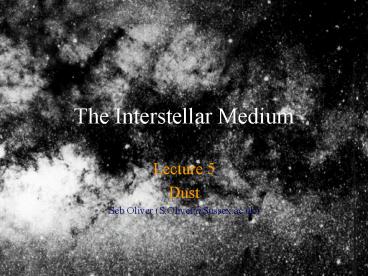The Interstellar Medium - PowerPoint PPT Presentation
1 / 23
Title: The Interstellar Medium
1
The Interstellar Medium
- Lecture 5
- Dust
- Seb Oliver (S.Oliver_at_Sussex.ac.uk)
2
Dust
- Evidence for dust
- absorption
- reddening
- polarisation
- emission
- Reddening and absorption
- Nature of dust
3
Evidence for Dust
- Zone of Avoidance
- Dark Clouds
- Absorption (extinction)
- Dust lanes in external spiral galaxies
- Reflection Nebulae
- Polarisation of starlight
- Reddening
- Emission in far infrared
4
Zone of avoidance
5
Zone of avoidance
- External galaxies appear to avoid the plane of
our galaxy
b
Example Sheet 3 Problem 3
6
Zone of avoidance
7
Dark Clouds
8
Dark Clouds
9
Dark Clouds
Dm
10
Absorption (extinction)
Observations of star clusters Star clusters
should have roughly the same size for the same
luminosity
star clusters are fainter by about 1 mag / kpc
than one would expect
Brighter
Fainter
11
Dust lanes in other galaxies
12
Reflection Nebulae
- Light from nebulae is bluer than illuminating
source - Light is also polarised
- suggests scattered by dust
13
Scattering
No Gas/ Dust
Gas/Dust again
Gas/ Dust
14
Scattering
Blue light is more easily scattered and absorbed
15
Reddening
- Distant stars appear redder than nearby ones
- The degree of reddening is proportional to the
amount of extinction or scattering
16
Reflection Nebulae
Different polarisations of light are scattered in
different directions, depending on their
orientations with respect to the scattering
grains
17
Polarisation of starlight
Seb Oliver polarization across galactic plane
- The light from many stars is weakly polarised
- The amount of polarisation depends on the amount
of extinction - Amount of polarisation increases towards galactic
plane
18
Emission from Dust
IRAS map at 100µm
The dust is heated by the photons it absorbs and
emits in the FAR infrared
19
Absorption Reddening
- Reddening is measured using a colour excess
- Extinction is defined
- Thus normalised extinction
20
Absorption Reddening
From observed extinction curves we see that the
extinction goes to zero and thus
as
and hence
21
Nature of the dust grainsPhysics
- From the IR to the near UV the normalised
extinction is almost linear in frequency
which implies
(see examples) - Charged particles give a scattering that is
independent of wavelength, and atoms and
molecules give a l-4 dependence - need grains of size comparable with visible
light, i.e. 0.1µm
22
Nature of the dust grains Chemistry
- Graphite grains can explain the UV bump
- Silicates can explain the far UV extinction
- Silicates can also explain some IR bands
- PAH (polycyclic aromatic hydrocarbons)
23
Nature of the dust grains Birth
- Formation is thought to occur in the outflowing
gas surrounding cool stars - .. But also perhaps Supernovae
- Most of the Carbon Oxygen forms CO
- Graphites and silicates can then form from the
more abundant remaining atoms
24
Nature of the dust grainsDeath
- Grains will be destroyed by collisions with fast
moving particles (sputtering) in hot gas (i.e. in
the corona)































